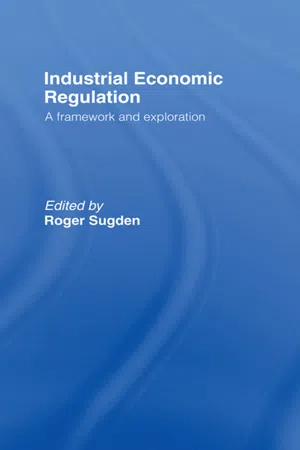Economics
Economic Efficiency
Economic efficiency refers to the optimal allocation of resources to maximize overall welfare. It occurs when goods and services are produced and distributed in a way that maximizes societal benefit while minimizing waste. This concept is a key focus in economic analysis and policy-making, aiming to achieve the most favorable outcomes for society as a whole.
Written by Perlego with AI-assistance
Related key terms
4 Key excerpts on "Economic Efficiency"
- eBook - ePub
- Jesús Huerta De Soto(Author)
- 2008(Publication Date)
- Routledge(Publisher)
We can conclude, then, that within the context of welfare economics, a striking similarity in form exists between the concept of technical efficiency and the static notion of Economic Efficiency. To put it another way: the static conception of economics reduces the principle of Economic Efficiency to a simple technical issue of maximization, which in any case could be resolved with a mere computer into which someone would enter the data always presumed known in the models of static efficiency. 22 Nevertheless, regardless of the importance of the above critical assessments, they fall short of what we see as the essential criticism to be levelled against the different efficiency standards propounded within welfare economics: that these standards focus solely on one of the two aspects of Economic Efficiency, namely the static aspect, which entails the presumption both that resources are given and constant, and that the fundamental economic challenge is to avoid wasting them. Furthermore, when, for example, a company, social institution or entire economic system is to be judged, such criteria completely ignore its Dynamic Efficiency, understood as its capacity to foster entrepreneurial creativity as well as coordination; in other words, the entrepreneurial capacity to seek, discover, and overcome different social maladjustments. In fact, we believe our most important goal should not be to move the system toward the production possibilities frontier (while deeming the corresponding curve ‘given’), but rather to systematically apply the criterion of dynamic efficiency, which focuses on the capacity of the system to continually ‘shift’ the production possibilities curve to the right. Thus the importance of overcoming the traditional static criteria of Economic Efficiency with a more complete, alternative standard which takes into account the dynamic dimension of every economic system - eBook - ePub
- Susan Miller(Author)
- 2011(Publication Date)
- SAGE Publications(Publisher)
The question now arises of whether dis-economies of scale – rising long-run average costs – are inevitable and unavoidable as the scale is continuously expanded. On this point, the jury is still out. At any given time, precipitous increases in scale through investment in new facilities or through mergers and acquisitions will incur higher unit costs as the existing management and other resources are stretched and unanticipated issues and events are met.However in the longer term operations can be rationalized and technical, marketing, information and managerial systems will improve, and knowledge and experience will increase. Globalization has seen the development of innovative and strongly competitive enterprises of unprecedented scale and with worldwide reach. Therefore dis-economies of scale may not be inevitable. But to set against this complacency, there is an extensive array of examples of disastrous mergers that have destroyed shareholder value.Pareto efficiency
Having now reviewed the characteristics of demand, supply and markets, the economist’s idea of overall, or economic, efficiency can be explained. Economic Efficiency takes account of both technical efficiency, which requires least-cost production, and allocative efficiency, which requires that scarce outputs from scarce resources are distributed efficiently among consumers. Achieving Economic Efficiency is often termed a Pareto optimum, after the Italian economist Vilfredo Pareto (1848–1923). The prime principle of such an optimum is that no agent, consumer or producer can be made better off without making another agent worse off.Economic Efficiency - eBook - ePub
Industrial Economic Regulation
A Framework and Exploration
- Roger Sugden(Author)
- 1993(Publication Date)
- Routledge(Publisher)
The first and second theorems of welfare economics essentially say, respectively, that every competitive equilibrium is Pareto-efficient (no one can be made better off without making someone else worse off), and that every Pareto-efficient allocation can be achieved as a competitive equilibrium for some distribution of the endowments. (For a discussion of these theorems, see an intermediate microeconomics text such as Varian 1987, chapter 29.) Clearly then, if distribution of endowments is satisfactory (and this is a big question), it is best to go for a competitive economy. This is one clear way in which we can ensure that the economy operates as efficiently as possible, given total endowments and current state of technological knowledge. Then it is allocatively, and by assumption also technically, efficient.Allocative efficiency implies the equation of relative marginal benefits of goods between consumers, and the equation of these marginal rates of substitution to ratios of prices or marginal (social) costs of production. In symbols:where x and y are two sample goods, i and j are two representative consumers, mu is marginal utility, and me is marginal cost. Allocative efficiency has nothing directly to do with the initial endowments.It is well known however, that various factors can get in the way of this seemingly simple strategy, the pursuit of competition. One of these is increasing returns to scale and, associated with this, monopoly. Monopoly can exist without scale economies, but their presence renders large number competition of the type envisaged above impossible, as we see later. Increasing returns violate one of the cornerstone assumptions of the production side of the competitive equilibrium model, convex production sets.A second factor is externalities, mainly detrimental externalities in practice, and their effect upon the model. All agents’ actions will have influence on other agents through prices (e.g. my purchase of a good will, infinitesimally, affect the price others pay). But where there is a non-priced effect, as with air pollution for example, allocative inefficiency will result. The social cost of the activity differs from the private cost.Thirdly, economies in practice involve not just private goods, but also goods which are to a greater or lesser extent public. Provision of a good such as street lighting or television broadcasting does not lend itself readily to pure pricing solutions. How can people be persuaded to pay up to their marginal valuation for a good which they will receive in any case? - eBook - ePub
- Sydney N. Afriat(Author)
- 2006(Publication Date)
- Routledge(Publisher)
cost-efficient, obtaining the given benefit at minimum cost.The terms efficient and effective have a difference here, which might appear to deny they are synonyms. However, they are employed to distinguish two types of efficiency, or effectiveness, just as in the study of the two social groups to which a reference has been made.Effectivity functions in game theory, introduced by Moulin and Peleg (1982) , show another area where ‘effectiveness’ has made an entry. Such a function describes, for each coalition S, the set of subsets within which S can force an outcome by means of some coordinated action of its members.2 This use seems in line with expressions about a medical treatment, or some agency or institution, or person, being effective or ineffective, as concerns production of intended outcomes.2 For awareness of this subject and information about it, I amindebted to Stefano Vannucci, University of Siena, for personal communications in addition to his papers (1999).Typical Economic Efficiency concepts have to do with production. In a first notion of a production function f, it determines the output q = f(x) obtained with any inputsx ∈ C ..3 Quite usually now, it instead determines the maximum possible output for the given inputs, so q ≤ f (x) for any feasible input-output operationThe efficiency of the operation is then e = q/f(x), that is, actual output as a fraction of the maximum possible. This quotient has also been called the coefficient of resource utilization. Necessarily 0 ≤ e ≤ 1, with e =(∈ C × Ω .x , q)
Learn about this page
Index pages curate the most relevant extracts from our library of academic textbooks. They’ve been created using an in-house natural language model (NLM), each adding context and meaning to key research topics.



